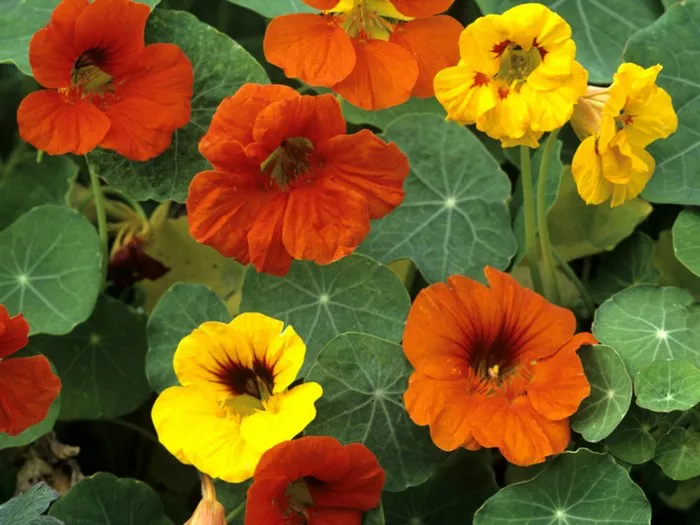Before delving into preservation techniques, it’s essential to understand the nature of nasturtium flowers. Nasturtiums (Tropaeolum majus) are annual plants native to South America, known for their vibrant flowers and round, shield-shaped leaves. These versatile plants come in a range of colors, including shades of red, orange, yellow, and cream.
Aside from their ornamental value, nasturtium flowers are edible and boast a distinctive peppery flavor reminiscent of watercress. Their culinary applications range from garnishing salads to infusing vinegars and making flavorful spreads. Additionally, nasturtiums attract pollinators to the garden, making them beneficial for overall biodiversity.
Preservation Methods for Nasturtium Flowers
Preserving nasturtium flowers requires careful handling and the use of appropriate techniques to maintain their color, texture, and flavor. Below are several methods you can employ to preserve these charming blooms:
1. Drying Nasturtium Flowers:
Drying is one of the most traditional methods of preserving flowers, including nasturtiums. Here’s how to dry nasturtium flowers effectively:
- Choose freshly harvested nasturtium flowers with no signs of wilting or browning.
- Gently remove excess moisture from the flowers by patting them with a clean towel.
- Arrange the flowers in a single layer on a drying rack or a mesh screen, ensuring they are not touching.
- Place the drying rack in a well-ventilated area away from direct sunlight and moisture.
- Allow the flowers to air dry for 1-2 weeks until they are completely dehydrated and crispy to the touch.
- Once dried, store the nasturtium flowers in an airtight container away from light and moisture to prevent them from reabsorbing humidity.
Dried nasturtium flowers can be used for culinary purposes, such as garnishing dishes or infusing teas, or incorporated into potpourri and decorative crafts.
2. Pressing Nasturtium Flowers:
Pressing is another method commonly used to preserve the delicate beauty of nasturtium flowers. Follow these steps to press nasturtium flowers effectively:
- Select fresh, unblemished nasturtium flowers for pressing.
- Place the flowers between two sheets of absorbent paper, such as blotting paper or parchment paper.
- Arrange the flowers in a single layer, ensuring they are not overlapping.
- Gently press down on the flowers to flatten them without crushing them entirely.
- Place the paper with the flowers between the pages of a heavy book or a flower press.
- Stack additional books or add weight to the press to apply consistent pressure.
- Allow the flowers to press for 1-2 weeks, periodically checking their progress and replacing the absorbent paper if necessary.
- Once fully pressed and dried, carefully remove the flowers from the paper and store them in a dry, dark place or use them for decorative purposes.
Pressed nasturtium flowers retain their vibrant colors and can be used to adorn cards, stationery, or framed artwork.
3. Freezing Nasturtium Flowers:
Freezing is an excellent preservation method for retaining the fresh appearance and flavor of nasturtium flowers. Here’s how to freeze nasturtium flowers properly:
- Start by selecting freshly harvested nasturtium flowers and gently rinsing them under cold water to remove any dirt or insects.
- Pat the flowers dry with a clean towel to remove excess moisture.
- Place the flowers in a single layer on a baking sheet lined with parchment paper, ensuring they are not touching.
- Place the baking sheet in the freezer and allow the flowers to freeze solid for 1-2 hours.
- Once frozen, transfer the flowers to an airtight container or freezer bag, removing as much air as possible before sealing.
- Label the container with the date and contents and return it to the freezer.
- Frozen nasturtium flowers can be stored for several months and used directly from the freezer in culinary applications such as garnishing salads or cocktails.
Freezing preserves the color and texture of nasturtium flowers, making them an excellent option for future culinary endeavors.
4. Candying Nasturtium Flowers:
Candying is a creative way to preserve nasturtium flowers while adding a touch of sweetness. Follow these steps to candy nasturtium flowers:
- Begin by preparing a simple syrup using equal parts water and granulated sugar. Heat the mixture in a saucepan over medium heat, stirring until the sugar is completely dissolved.
- Allow the syrup to cool slightly before carefully dipping each nasturtium flower into the syrup, coating it thoroughly.
- Place the candied flowers on a wire rack or parchment paper to dry, ensuring they are not touching.
- Allow the flowers to dry completely, which may take 12-24 hours, depending on humidity levels.
- Once dry, store the candied nasturtium flowers in an airtight container in a cool, dry place away from direct sunlight.
Candied nasturtium flowers make delightful garnishes for desserts or cocktails and can also be enjoyed as sweet treats on their own.
Tips for Preserving Nasturtium Flowers Successfully:
- Harvest nasturtium flowers in the morning when they are at their freshest and fullest.
- Handle the flowers gently to avoid bruising or damaging them during the preservation process.
- Choose only healthy, pesticide-free flowers for preservation to ensure the best quality and flavor.
- Store preserved nasturtium flowers in airtight containers away from light, heat, and moisture to maintain their freshness and color.
- Experiment with different preservation methods and applications to discover the most suitable option for your needs and preferences.
Conclusion
Preserving nasturtium flowers allows you to prolong their beauty and enjoy their culinary and decorative benefits long after their blooming season has ended. Whether you prefer drying, pressing, freezing, or candying, there are various methods to choose from, each offering its unique advantages. By following the techniques outlined in this guide and incorporating proper storage practices, you can preserve nasturtium flowers successfully and enhance your culinary creations and floral arrangements with their vibrant colors and peppery flavor.


